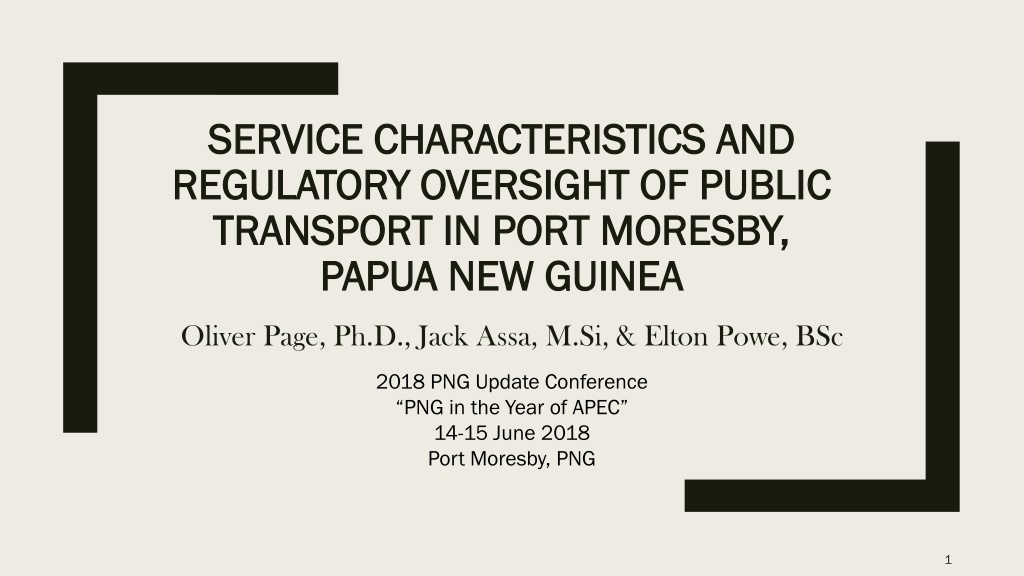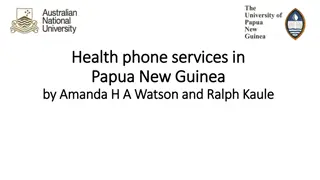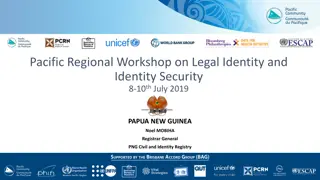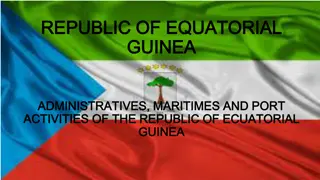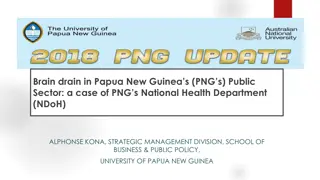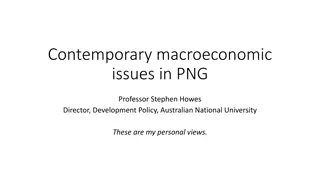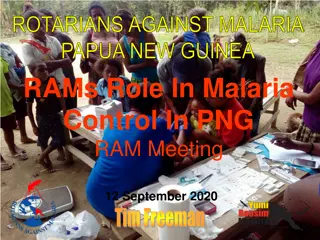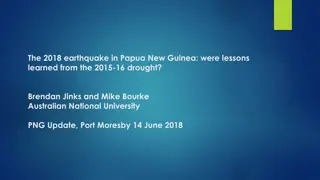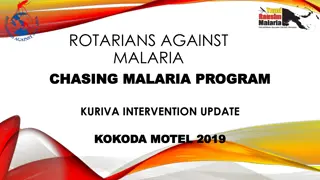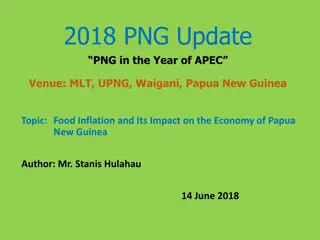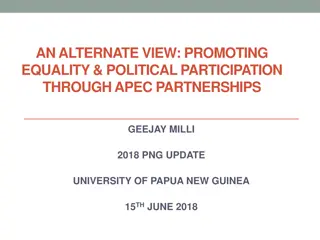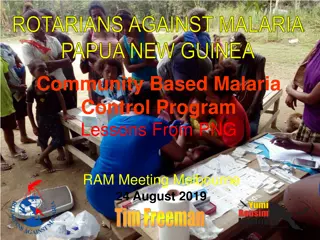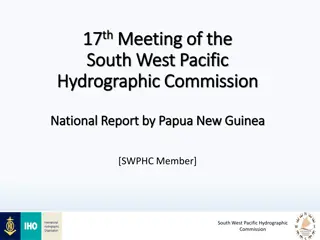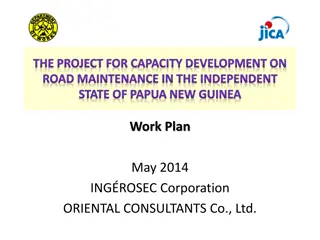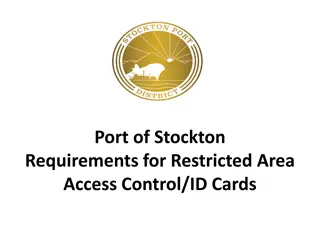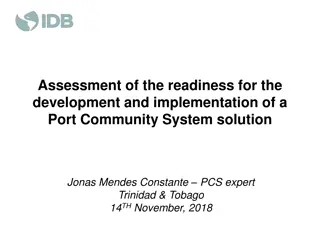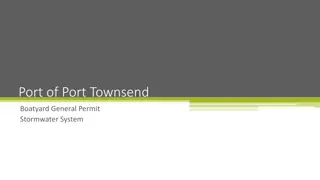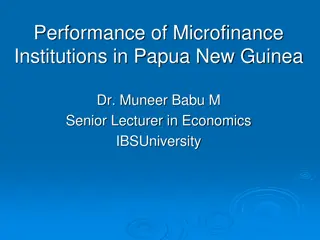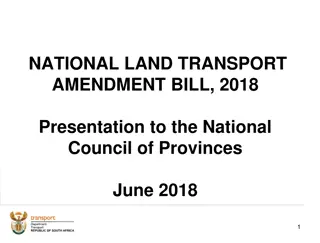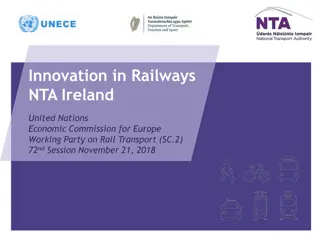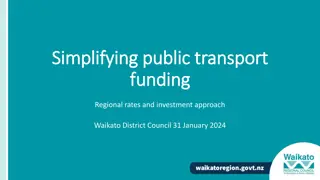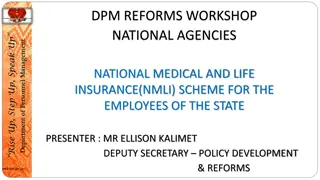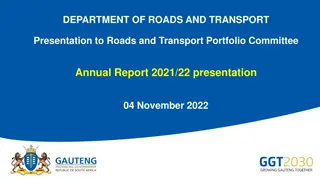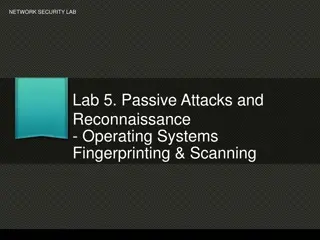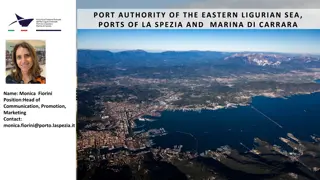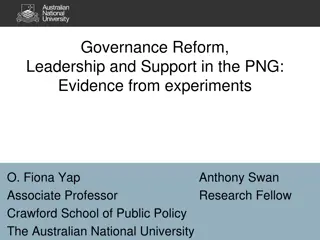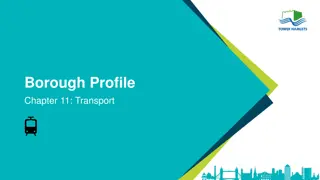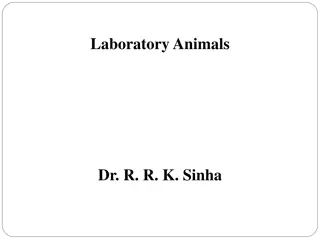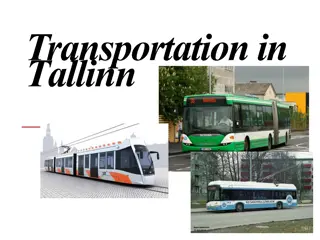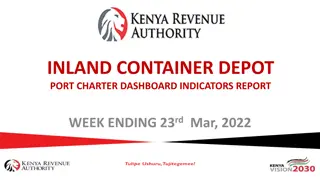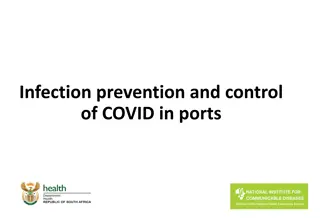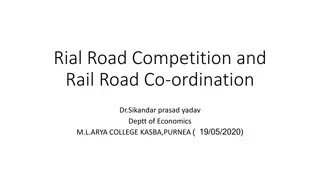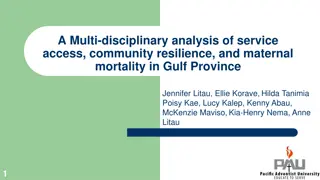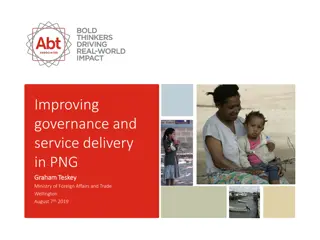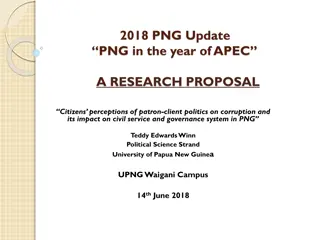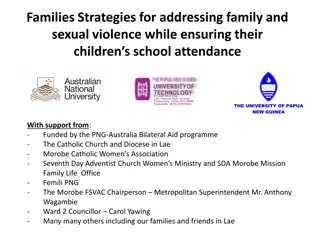Public Transport Service Characteristics in Port Moresby, Papua New Guinea
This study delves into the public transport service characteristics and regulatory oversight in Port Moresby, the capital city of Papua New Guinea. It covers the historical timeline, vehicle types, population, permits, and ownership details of public transportation in the city. The objective is to identify the key aspects of the public transport system in the rapidly growing urban center.
Download Presentation

Please find below an Image/Link to download the presentation.
The content on the website is provided AS IS for your information and personal use only. It may not be sold, licensed, or shared on other websites without obtaining consent from the author. Download presentation by click this link. If you encounter any issues during the download, it is possible that the publisher has removed the file from their server.
E N D
Presentation Transcript
SERVICE CHARACTERISTICS AND SERVICE CHARACTERISTICS AND REGULATORY OVERSIGHT OF PUBLIC REGULATORY OVERSIGHT OF PUBLIC TRANSPORT IN PORT MORESBY, TRANSPORT IN PORT MORESBY, PAPUA NEW GUINEA PAPUA NEW GUINEA Oliver Page, Ph.D., Jack Assa, M.Si, & Elton Powe, BSc 2018 PNG Update Conference PNG in the Year of APEC 14-15 June 2018 Port Moresby, PNG 1
Introduction Introduction Papua New Guinea (PNG)(Population ~8 million) Port Moresby capital city of PNG 364,125 persons, approximately 5 percent of PNG s total population of 7.25 million (2011) 240km2 (~ 93 square miles) approximate land area 20 planned settlements, 79 informal settlements and 7 urban villages (2013) Study objective to identify public transport service characteristics and regulatory framework in the rapidly growing city of Port Moresby 2
Characteristic #1: Historical Timeline of Public Transport Characteristic #1: Historical Timeline of Public Transport 1960s+ 1960s+ PMVs (privately owned) operate anywhere and anytime in Port Moresby Port Moresby Bus Company (government owned) competed with PMVs 1968 1968 Establishment of the National Land Transport Board (NTLB) 1973 1973 Operating licences issued to Indigenous Papuans 1981 1981 Port Moresby Bus Company liquidated 1987 1987 NTLB licenses PMVs to operate on specific routes 1997 1997 Establishment of National Road Safety Council (NRSC) 2002 2002 Establishment of Independent Consumer and Competition Commission (ICCC) 2014 2014 UN Women PNG investigate public transport safety of Women and Girls Road Traffic Act passed 2015 2015 Meri Seif Bus (Women only) commences operations in Port Moresby 2016 2016 Establishment of the Road Traffic Authority (RTA) 2017 RTA -Transport Act passed (Various Acts Amended) 2018 June (1st) New Regulations and Rules comes into play 3
Characteristic #2: Vehicle Type, Population Characteristic #2: Vehicle Type, Population and Permits and Permits Type Type Capacity/ Capacity/ Seats (including Seats (including operator s seat) operator s seat) 25 Routes Routes Official Number Official Number of Registered of Registered Vehicles (2015) Vehicles (2015) 800 Ownership Ownership Notes Notes Coaster Bus Coaster Bus (Toyota) (Toyota) Minibus Minibus Intra-urban routes within the city Inter-urban Routes to/from outside of the city Intra-urban routes within the city Intra-urban routes within the city Private In addition, there are an unknown number of unregistered PMVs 15 To be determined Private Taxi Taxi 5 970 Private Comeng/Volvo Comeng/Volvo (Conventional (Conventional Bus) Bus) 44 6 Ginigoada Bisnis Development Foundation (Nonprofit) Public Meri Seif Bus (UN Women owned and operated by NCDC: Only for women) Ashok Leyland Ashok Leyland (Conventional (Conventional Bus) Bus) 50 Intra-urban routes within the city 19 Owned and operated by the NCDC 4
Characteristic #2: Vehicle Type, Characteristic #2: Vehicle Type, Population and Permits Population and Permits Route permit required to operate on any PMV route Route permits valid for six (6) months Route Permits issued to the PMV or Taxi owner by NLTB/Road Traffic Authority (RTA) PMV ceiling for any route is 60 permits (irrespective of passenger demand) 5
Characteristic #3: Port Moresby PMV & Meri Characteristic #3: Port Moresby PMV & Meri Seif Seif Route Network (Active) Route Network (Active) Route From (Start) To (End) Distance (KM) Route From (Start) To (End) Distance (KM) 15 4Mile 7 Mile 3 4 Gordons Down Town 10 15 Hohola 4mile 3 6 Hohola Gordons 7 16 Gordons Bomana 9 7 Gerehu Gordons 8 16 Gordons ATS 5 7 Waigani Market Gordons 2 16 Gordons Goldie Army Barracks 13 9 Gerehu 4 Mile 9 17 Gordons Manu 6 9 Gerehu Down Town 8 19 Taurama Manu 4 10 Manu Down Town 7 21 Town Hanuabada 4 11 Waigani Market Down Town 10 21 Town Vabukori 3 11 4 Mile Waigani Office 4 22 Down Town Baruni 8 11 4 Mile Waigani Market 4 Meri Seif - Women Only routes 12 Manu Hohola 4 1 Gerehu Down Town 14 12 Hohola Tokarara 3 2 9Miles Down Town 10 12 Waigani Hohola 2 3 Morata Manu 11 6 13 Gordons Manu 5
Characteristic #4: Women Unfriendly Characteristic #4: Women Unfriendly In 2014 82% female PMV users felt unsafe while waiting for PMVs and 79% riding in them (UN Women PNG) PMVs stops at or near markets were known hot spots of sexual violence or sexual harassment Female market vendors travelling after dusk are forced to use taxis to return home Walking further distances than necessary places women and girls in a vulnerable position to experience unwanted sexual violence or harassment 8
Characteristic #5: Disabled Unfriendly Characteristic #5: Disabled Unfriendly Multiple steps to board/alight from vehicle Overloaded PMVs especially during peak times Lack of priority or preferential seating Narrow aisles in conventional buses & PMVs Some boarding locations impossible to reach during rainy season 9
Characteristic #5: Disabled Unfriendly Characteristic #5: Disabled Unfriendly Private taxis used if funds available Some taxi operators charge disabled riders more to recoup lost revenue 1 1 2 2 3 3 No taxis or PMVs are disabled friendly Shared taxis often do not stop for disabled person 4 4 5 5 6 6 7 7 8 8 9 9 10
Characteristic #6: Traffic Safety and Vehicle Characteristic #6: Traffic Safety and Vehicle Maintenance Maintenance Typical PMV Operating Conditions: Overloaded and unroadworthy vehicles High crash rates Multiple and persistent violations of traffic safety regulations Wilfully dangerous operation of vehicles Accident/Traffic Crash factors: Drunk driving Inadequate road safety awareness by drivers and pedestrians Absence of uniform traffic engineering standards Accident blackspots Inadequate enforcement of traffic rules 11
Regulatory Framework & Stakeholders Regulatory Framework & Stakeholders 12
Regulatory Framework & Road Traffic Authority Regulatory Framework & Road Traffic Authority RTA established in 2016 Proposed agency described in Medium Term Transport Plan 2013 Streamline fragmented transport regulatory system Address inefficiencies in transport operations, regulations and enforcement Consolidate functions of Land Transport Division (LTD), the Land Transport Board (LTB) and the National Road Safety Council (NRSC) RTA primary public transport regulator in the NCD/Port Moresby Determine Routes Issue Permits Vehicle Registration Drivers Licensing Transport Licensing Traffic Enforcement Vehicle Inspection & Compliance 13
What have we learnt? What have we learnt? Route needs identification and PMV route permitting has failed to keep up with demand Lack of PMV route enforcement leaves many passenger groups underserved and inconvenienced Fragmented regulatory system and limited enforcement of existing rules has contributed to an inadequate PMV and taxi system Women, girls and the disabled are underserved users of public transport Consolidation of functions within the RTA together with sustainable financing has the potential to significantly improve public transport operations in NCD 14
Recommendations Recommendations Establishment of an Advocacy Group for PWD public transport users Revisit the design of public transport infrastructure, facilities and PMV operating practices that includes all users (women, girls, elderly and disabled) Continued consolidation of permit issue, route needs identification, regulatory oversight, etc., with the RTA Identify low cost interventions to increase route capacity with existing PMVs 15
Acknowledgements Acknowledgements Thank You/ Thank You/Tenkyu Any Questions? Any Questions? Tenkyu Wilson Wariaka, MT (Civil), BE (Civil), MIEPNG, Reg. Eng Road Traffic Authority (Papua New Guinea) Oliver Page, Ph.D. U.S.A. o.a.page@gmail.com National Road Traffic Authority (NRTA) Jack Assa, M.Si Papua New Guinea jackassa945@gmail.com Cheshire disAbility Services Participants of Focus Groups and Key Informants Elton Powe, BSc Papua New Guinea eltonpowe@gmail.com UN Women Papua New Guinea 16
